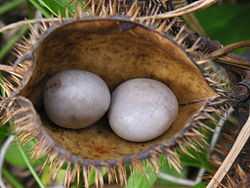Nickernut

Nickernuts or nickar nuts are smooth, shiny seeds from tropical leguminous shrubs, particularly Caesalpinia bonduc and C. major,[1] both known by the common name warri tree. C. bonduc produces gray nickernuts, and C. major produces yellow. Accordingly, these species are locally known in the Caribbean as "grey nickers" and "yellow nickers".
The word nicker probably derives from the Dutch word "knikker", meaning clay marble.[2]
In the Caribbean, nickernuts are used to play mancala games such as oware. The nickernut is marble-like and good for other uses, such as for jewellery; it is also sometimes ground up to make a medicinal tea.[1]
The seeds are often found on the beach, and are also known as sea pearls[3] or eaglestones.[4]
Caesalpinia and Merremia seeds sometimes drift long distances. In 1693 James Wallace referred to them being often found in Orkney: "After Storms of Westerly Wind amongst the Sea-weed, they find commonly in places expos'd to the Western-Ocean these Phaseoli . . . . [F]rom the West-Indies, where they commonly grow, they may be thrown in on Ireland, the Western parts of Scotland and Orkney".[5] In 1751 Erich Pontoppidan described one found on the coast of Norway: "It is of the size of a chestnut, obicular, yet flat, or as it were compressed on both sides. Its colour is a dark brown yet in the middle, at the junction of the shells, it is varied with a circle of shining-black, and close by that another of a lively red, which have a very pretty effect".[6] They were known as 'sea beans' in Scandinavia, where one has been found fossilised in a Swedish bog,[7] and 'Molucca beans' in the Hebrides, where a visitor to Islay in 1772 wrote of them as seeds of "Dolichos wrens, Guilamdina Bonduc, G. Bonducetta, and mimosa scandens . . . natives of Jamaica".[8] The 1797 Edition of the Encyclopaedia Britannica said that they were used only for "the making of snuff-boxes out of them";[9] however, there is a long tradition of using them as amulets for good luck,[2] banishment of ill luck[10] or to ease childbirth.[11]
Gallery
-

Caesalpinia bonduc leaves in Krishna Wildlife Sanctuary, Andhra Pradesh, India.
-

Caesalpinia bonduc flowers in Krishna Wildlife Sanctuary, Andhra Pradesh, India.
-

Caesalpinia bonduc flowers in Krishna Wildlife Sanctuary, Andhra Pradesh, India.
-

Caesalpinia bonduc Unripe nickernut seed pods at Port Canaveral, Florida.
References
- ↑ 1.0 1.1 "The Fabulous Nickernuts", Wayne's Word vol. 6 no. 3, Fall 1997, retrieved 1 June 2010.
- ↑ 2.0 2.1 West Word March 2002, retrieved 1 June 2010.
- ↑ "Gray Nickarbean or Sea Pearl". A Sea-Bean Guide. Retrieved 2009-01-28.
- ↑ "Nickarbeans and Sea Pearls". Beachbeans.com. Retrieved 2009-03-23.
- ↑ James Wallace, A Description of the Isles of Orkney, 1693, 2nd ed. ed. John Small, Edinburgh: William Brown, 1883, OCLC 4383160, p. 183.
- ↑ Cited in Jack D. Forbes, The American Discovery of Europe, Urbana: University of Illinois, 2007, ISBN 0-252-03152-0, p. 29.
- ↑ Forbes, p. 30.
- ↑ Forbes, p. 30.
- ↑ "Orkney", vol. 13, p. 500.
- ↑ Forbes, pp. 29-30: tied around children's necks in the Hebrides around 1700, the white ones used as talismans as late as 1948 and called "St. Mary's beans".
- ↑ Audrey Meaney, "Drift Seeds and the Brísingamen", Folklore 94.1 (1983) 33-39, p. 33. In addition to 'sea-beans' they are called lausnarsteinar, 'birth stones', Iceland and vettenyrer, 'wight kidneys', in the Faroes and Norway.
Sources
- E. Charles Nelson and P. H. Oswald. Ed. Wendy Walsh. Sea Beans and Nickar Nuts: A Handbook of Exotic Seeds and Fruits Stranded on Beaches in North-Western Europe. Botanical Society of the British Isles, 2000. B.S.B.I. Handbooks for Physical Identification 10. ISBN 0-901158-29-1
| Wikimedia Commons has media related to Nickernut. |


